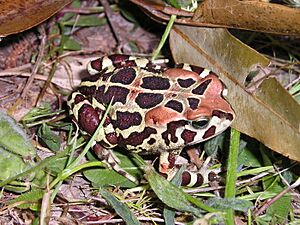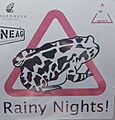Western leopard toad facts for kids
The western leopard toad (Sclerophrys pantherina) is a special type of toad found only in certain parts of South Africa. It's known for its beautiful spotted skin, which looks a bit like a leopard's coat! These toads live in the low-lying areas of the Cape Peninsula, the Cape Flats, and the Agulhas flats in the Western Cape province.
Quick facts for kids Western leopard toad |
|
|---|---|
 |
|
| Conservation status | |
| Scientific classification | |
| Synonyms | |
|
Contents
Where Do Western Leopard Toads Live?
These toads live in two main areas, often called the Cape Town and Overberg groups. They like places with Mediterranean-type plants, like the fynbos and dune areas around Cape Town.
Toad Homes in the Suburbs
Western leopard toads are quite adaptable! They don't just live in wild, untouched places. Many of their natural feeding grounds are now covered by houses and gardens. This means you can often find these toads living right in suburban gardens.
Where Toads Lay Their Eggs
When it's time to lay eggs, these toads look for water. They use places like swamps, lakes, and marshes. They also use water areas in cities, like urban streams, and even ponds in people's gardens.
What Threats Do Western Leopard Toads Face?
Sadly, these amazing toads face many dangers. One big problem is habitat loss. This happens when their natural homes are destroyed to build new houses or roads.
Dangers in the City
Living in a growing city like Cape Town means facing urban obstacles. Things like high walls, electric fences, canals, and busy roads can be very dangerous for toads. They can get trapped or run over.
New Dangers from Other Animals
Sometimes, new animals or plants that aren't native to the area can cause problems. Ducks and fish that are introduced to ponds can eat toad eggs or young toads. Certain types of algae can also harm their breeding spots.
How Are People Helping Western Leopard Toads?
Many people are working hard to protect the western leopard toad. Volunteers play a super important role in these efforts!
Helping Toads Cross Roads
Volunteers are especially busy during the toad's breeding season. This usually happens between late July and early September, when the weather gets warmer after winter. This is when many toads move to and from their breeding ponds, often crossing busy roads.
Community Efforts to Save Toads
During this time, volunteers work at night to help toads cross roads safely. They also collect information about the toads and wave down drivers to warn them. Since 2011, special road signs have been put up at ten toad crossing spots. These signs remind drivers to slow down and watch out for the toads, especially at night.
Images for kids



